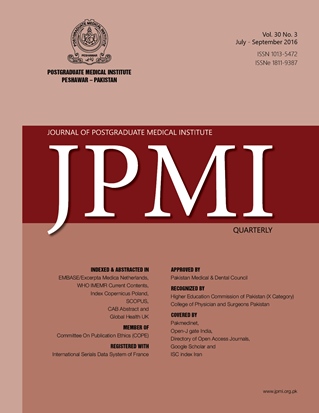CLINICAL PRESENTATION AND OUTCOME OF TRAUMATIC EPIDURAL HEMATOMAS IN POSTERIOR FOSSA: STUDY OF 34 CASES
Main Article Content
Abstract
Objective: To determine the clinical presentation and outcome of traumatic
epidural hematoma in posterior fossa.
Methodology: This observational study was conducted in Department of
Neurosurgery Lady Reading Hospital, Peshawar from 30th November 2009 to
29th November 2014. We collected data for both operated and non-operated
cases of traumatic posterior fossa epidural hematoma, of any gender and age.
Patients were followed for 6 months and all the data was analyzed by SPSS
version 20 and presented in figures.
Results: Total 34 patients were included in the study having age range from
5-60 years with mean age of 32.5±16.24 years. Males were 25(73.52%) and
females were 9(26.47%). The most common cause was motor vehicle accident
found in 15(44%) cases. seventeen (50%) patients were managed conservatively,
while 17(50%) were managed by surgery. Good outcome was found in
28(82.35%) and in remaining 6(17.64%) there was poor outcome.
Conclusion: The frequency of posterior fossa epidural hematoma was more
in males. Motor vehicle accident was the most common cause in this study.
Good outcome was found in a significant number of treated patients.
epidural hematoma in posterior fossa.
Methodology: This observational study was conducted in Department of
Neurosurgery Lady Reading Hospital, Peshawar from 30th November 2009 to
29th November 2014. We collected data for both operated and non-operated
cases of traumatic posterior fossa epidural hematoma, of any gender and age.
Patients were followed for 6 months and all the data was analyzed by SPSS
version 20 and presented in figures.
Results: Total 34 patients were included in the study having age range from
5-60 years with mean age of 32.5±16.24 years. Males were 25(73.52%) and
females were 9(26.47%). The most common cause was motor vehicle accident
found in 15(44%) cases. seventeen (50%) patients were managed conservatively,
while 17(50%) were managed by surgery. Good outcome was found in
28(82.35%) and in remaining 6(17.64%) there was poor outcome.
Conclusion: The frequency of posterior fossa epidural hematoma was more
in males. Motor vehicle accident was the most common cause in this study.
Good outcome was found in a significant number of treated patients.
Article Details
How to Cite
1.
Haq NU, Azam F, Ishfaq M, Khan BZ, Jalal A. CLINICAL PRESENTATION AND OUTCOME OF TRAUMATIC EPIDURAL HEMATOMAS IN POSTERIOR FOSSA: STUDY OF 34 CASES. J Postgrad Med Inst [Internet]. 2016 Jul. 18 [cited 2025 Dec. 13];30(3). Available from: https://jpmi.org.pk/index.php/jpmi/article/view/1843
Issue
Section
Original Article
Work published in JPMI is licensed under a
Creative Commons Attribution-NonCommercial 2.0 Generic License.
Authors are permitted and encouraged to post their work online (e.g., in institutional repositories or on their website) prior to and during the submission process, as it can lead to productive exchanges, as well as earlier and greater citation of published work.


